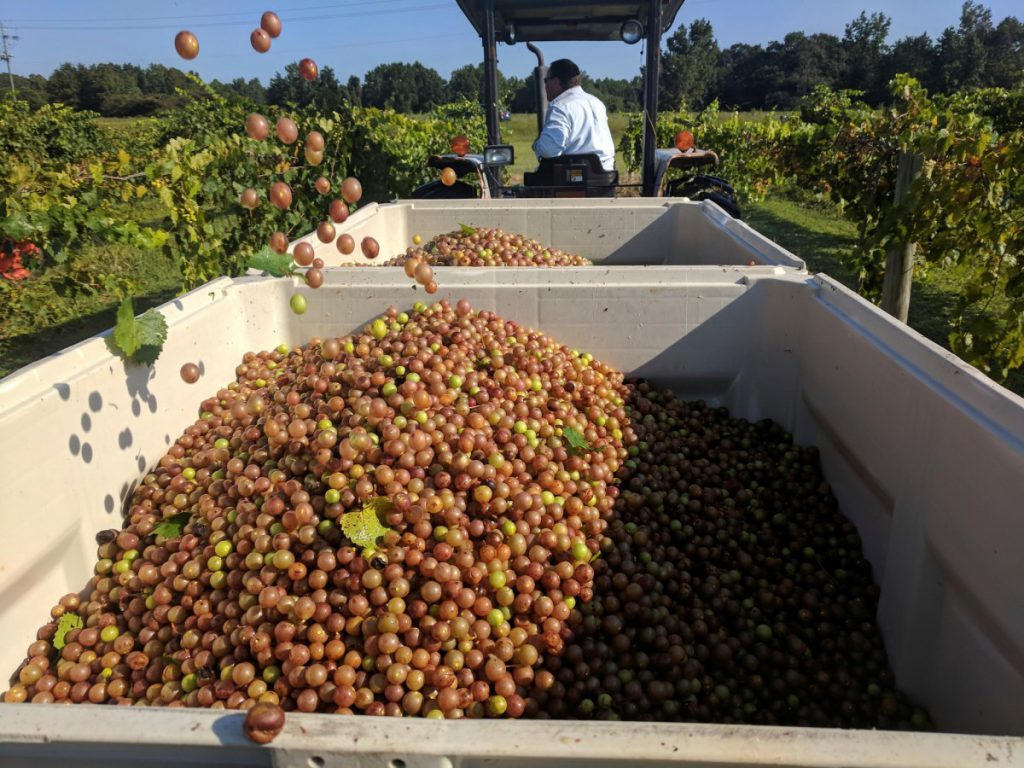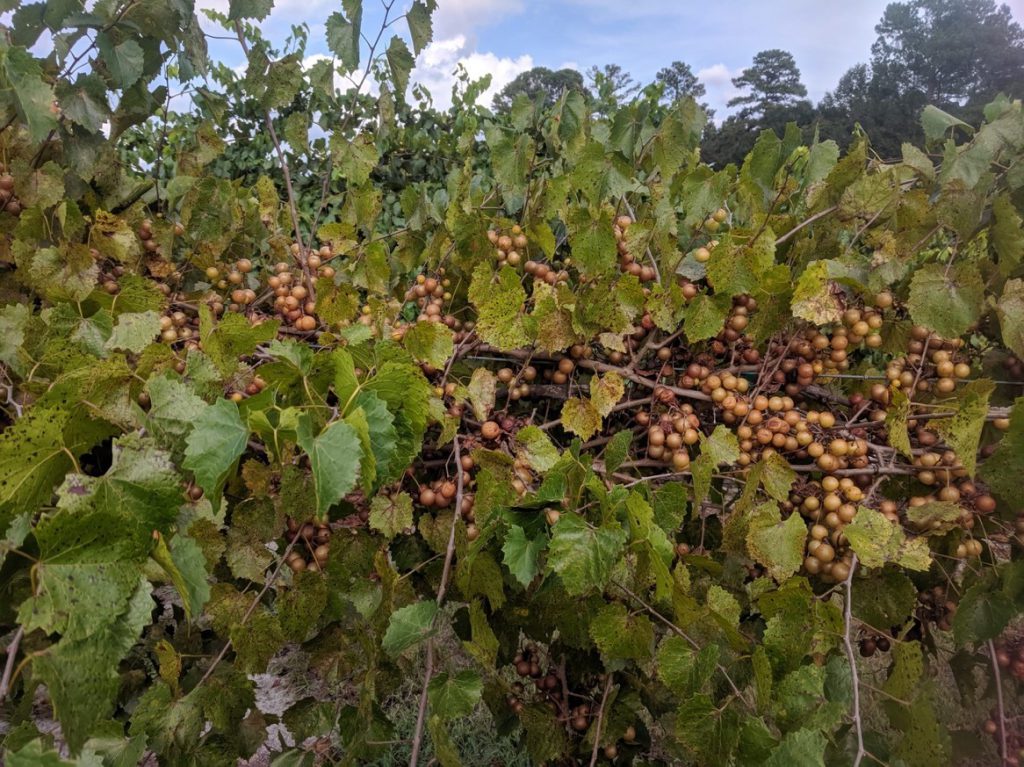Emma Volk, Research Technician, Small Fruits Research and Extension Group, NC State University.
Mark Hoffmann, Small Fruits Extension Specialist, Department of Horticultural Science, NC State University.

The muscadine industry in North Carolina is highly diverse and can be generally split into two large areas: commercial processing (wine production) and fresh-market sales. Those two areas contribute probably to 95% of all muscadines produced commercially in North Carolina. A third area, which we don’t discuss here, is the use of muscadines for the development of nutraceutical products. We have interviewed one owner of a fresh-market farm and one owner of a muscadine winery to give us their perspective on the largest muscadine industry in the U.S. and probably the world.
Fresh-market muscadines:
Ervin Lineberger is the owner and operator of Lineberger’s Killdeer Farm, where he grows over 30 acres of fresh market muscadines. As the growing season picked up, he found some time to talk to us about the ins and outs of growing muscadines in North Carolina.
Q1: Could you give our readers a brief description of your job and the farm you operate?
I own and run Lineberger’s Killdeer Farm. That name comes from the killdeer bird, and it was in place before I took over the farm. When we first started, we had u-pick strawberries, peaches, and other crops. But in the 80’s, we had so many spring freezes with peaches and got burned out with u-pick strawberries. We started to look for crops we could wholesale, not retail, and blackberries and muscadines came to the front. We now have 35 acres of fresh market muscadines. Most are sold to grocery stores, and some are sent to restaurants. A few seeded bunch grapes are grown and sold primarily for people who want to make juice. And we also have seedless bunch grapes. Currently, we are working with a breeding program developing seedless muscadines, so we have 6 acres of those. In addition to grapes, we also have 10 acres of blackberries.
Q2: Could you summarize a year-long cycle of muscadine production?
We’re coming out of the typical pruning period which starts around late December here and finishes up in May. Bloom is currently a week or week and a half away, and that’s why the muscadine is a great crop for the area. In North Carolina, fruits that bloom early risk getting frost damage. Muscadines bloom later than other berries, so cold damage is less likely in the spring.
Because we have different varieties here, harvest is staggered throughout the fall. We usually finish up in October with our last varieties. After harvest, vines go dormant, and we start the process over again with pruning in late December.
“Muscadines are probably one of the easiest grapes to grow if you want to grow organically”
Ervin Lineberger, Lineberger’s Killdeer Farm
Q3: What diseases or pests pose significant challenges to North Carolina muscadine growers?
Muscadine grapes are generally resistant to most diseases that other fruits have to deal with. The only major disease, I would say, is black rot which is a fungus that attacks the berry and the plant. But still it’s not a major threat. We spray for fungal diseases, but we only spray about 20% of what we typically spray blackberries because muscadines are just resistant. In fact, they’re probably one of the easiest grapes to grow if you want to grow organically. We don’t grow organically because customers usually shop for cosmetic features, so we have to spray for cosmetic effects. They shouldn’t be spotty. They need to be beautiful, if possible.
[eds: Colletotrichum species and Macrophoma are berry rots that also can be frequently observed on muscadine grapes later in the season and can lead to lower fruit quality and brown or black fruit]
When talking about insects, there are only a few to worry about. The Japanese beetle is a problem during the bloom period. We’ve recently had trouble with stink bugs, and we’ve had to use insecticides for that. But a general spray program that starts in Spring and goes into early August is usually effective for controlling insects.
[eds: In many areas of the Southeast, the Grape Root Borer can be a major insect pest on muscadines and can lead to die-off of muscadine plants]
Q4: What muscadine characteristics do customers favor?
Well, like I mentioned before, cosmetic appearances are very important to the customer. But beyond that, I’ve noticed that there are differences in preferences depending on the area of the state. In eastern North Carolina, there are bronze varieties that are by far the favorite. In other areas, the red ones are the favorite.
Right now, breeders are experimenting with colors and sizes and flavors. The University of Arkansas has a characteristic in one of their varieties that’s crunchy, and they’re very good. And I think the new varieties we’re looking at –particularly the seedless varieties – will have the potential to sell up North and beyond.
Q5: What is the hardest part about marketing fresh market muscadines?
Overall, the biggest challenge for marketing is education and how to promote our product because there are still so many people in the southeast that didn’t grow up with them. People my age grew up with them growing in their backyard, but that’s not necessarily the case anymore. I’m a firm believer that people will come back to buying something if they had a good experience when they bought it the first time. So I think we need to make sure it’s at peak ripeness when picked in order for customers to come back.
I think it’s also important to do a better job of selecting varieties that will lend themselves the fresh market. Some varieties have a tendency to split when they’re picked. And a split fruit is going to leak, get sticky, and not hold up very well in the store.
Price is another important factor. Keep in mind that we’re competing for shelf space with California table grapes. $1.99/lb for table grapes vs $3.99/lb for muscadines is going to force a customer to make a choice on price. Price is a key factor.
“People will come back to buying something if they had a good experience when they bought it the first time.”
Ervin Lineberger, Lineberger’s Killdeer Farm
Q6: What is one thing you wish customers/the public knew about this unique fruit?
By far, the answer is health benefits. That’s the one thing that I think if we could drive forward, it would help us. Of course, then, it’s also the flavor and the eating experience of a unique fruit.
Q7: Any last thoughts or comments on muscadine production in North Carolina?
Growers can make a profit growing muscadine grapes, so I would really encourage people to consider small, pick your own operations and growing for a local market. There is some profit in it, and a small vineyard doesn’t require a great deal of expense like large sprayers or large tractors. The winter time can be spent hand pruning. I think it’s an attractive business for anyone looking to run a small or large operation.
The muscadine wine industry:
After our discussion with Ervin, we wanted to learn more about the grape –particularly the history and future of muscadine wine. So we talked to Tina Smith, the president of Cypress Bend Vineyards, a business she started with her husband in the early 2000s. Together, they own and operate a winery, as well as a 35-acre vineyard where they grow muscadines and produce wine. Tina kindly took some time out of her day to answer some questions for us.
Q1: Could you give us a brief description of your job and your operation?
I’m the president of Cypress Bend Vineyards, and I started this operation with my husband back in 2001. When we first started, we grew muscadine grapes for other wineries, but we soon realized there was not a lot of profit in just selling the wine grapes so we decided to start our own winery. In 2005, we opened a winery on our property, and we’ve been growing muscadines and making wine from our vineyard very successfully ever since.
Q2: What muscadine wine characteristics do customers favor?
When people come into our winery, they often express that they like a more fruit forward sweet wine. Two of our most popular selling wines are our sweetest wines. However, we have a range of dry to semi dry and semi sweet to sweet wines to offer our customers which broadens their possibility to please any palate. Recently we started distributing our wines across the country, and it appears that northern states have a tendency to order drier wines. Meanwhile, southern states are more interested in sweeter wines.
Q3: What is the hardest part about marketing muscadine wine in NC?
The hardest part about selling our wine is convincing customers that not all muscadine wine is sweet. There’s a preconceived notion that muscadine wine means a sweet, syrupy drink. This could be due to the fact that most muscadine wine producers primarily provide very sweet wine, so that is what people expect. However, we have put a lot of time and effort into creating beautiful dry wines from the Muscadines and have educated our customers that muscadine wine grapes can make lovely dry to sweet wines.

“We should be proud of this grape and what we can do with it.”
Tina Smith, president of Cypress Bend Vineyards
Q4: What are the unique characteristics of muscadine wine?
Muscadine grapes only grow in certain regions of this country.Therefore making it unique in and of itself. In terms of the flavor, however, it’s very floral and aromatic. It also has a specific texture and structure to it. It was the first grape used in this country to make wine, and it is made from a grape indigenous to the Southeast. We should be proud of this grape and what we can do with it.
Q5: How would you convince someone to taste muscadine wine if they’ve never had it?
When someone comes into the winery and tells me they have never had muscadine wine, I ask them what they usually like to drink and then let them taste one of our wines that we feel is similar to what they usually drink. Based on their reaction, we then continue to offer other tastes of our wines that would please their palate. Usually, people find a wine they like after one or two samples. Muscadine wine is a variety of wine made from wine grapes just like the other 10,000 varieties of wine grapes that are used. It is wine –it has been produced by the same process of fermentation. We respect the quality and health benefits of the muscadine grape, and I think we’ve done a good job with that by offering award winning wines. We want everyone to respect it, too. Try it!
Both interviews were conducted by Emma Volk.